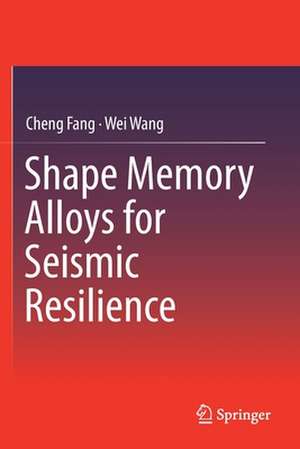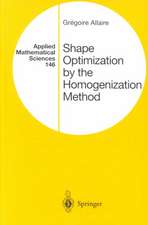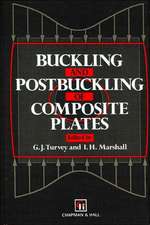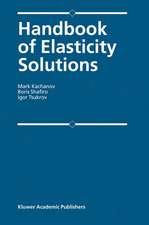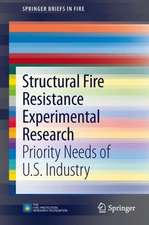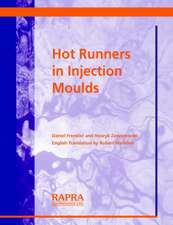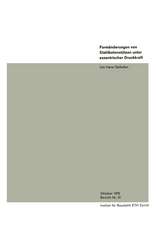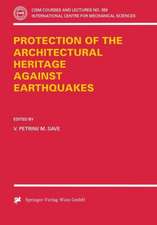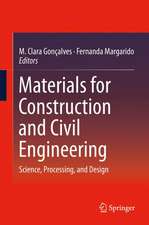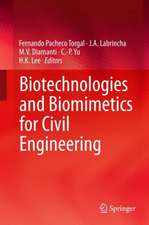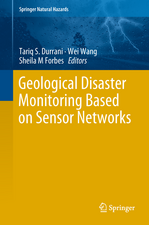Shape Memory Alloys for Seismic Resilience
Autor Cheng Fang, Wei Wangen Limba Engleză Paperback – 14 aug 2020
The book allows readers to gain an in-depth understanding of the working mechanisms of various SMA-based structural devices and members, including beam-to-column connections, dampers, and braces, while also providing them with a broader vision of next-generation, performance-based seismic design for novel adaptive structural systems. Helping to bridge the gap between material science and structural engineering, it also sheds light on the potential of commercializing SMA products in the construction industry. The cutting-edge research highlighted here provides technical incentives for design professionals, contractors, and building officials to use high-performance and smart materials in structural design, helping them stay at the forefront of construction technology.
| Toate formatele și edițiile | Preț | Express |
|---|---|---|
| Paperback (1) | 1108.51 lei 6-8 săpt. | |
| Springer Nature Singapore – 14 aug 2020 | 1108.51 lei 6-8 săpt. | |
| Hardback (1) | 1114.52 lei 6-8 săpt. | |
| Springer Nature Singapore – 4 iun 2019 | 1114.52 lei 6-8 săpt. |
Preț: 1108.51 lei
Preț vechi: 1351.83 lei
-18% Nou
Puncte Express: 1663
Preț estimativ în valută:
212.14€ • 220.66$ • 175.13£
212.14€ • 220.66$ • 175.13£
Carte tipărită la comandă
Livrare economică 14-28 aprilie
Preluare comenzi: 021 569.72.76
Specificații
ISBN-13: 9789811370427
ISBN-10: 9811370427
Pagini: 284
Ilustrații: XXI, 284 p. 238 illus., 158 illus. in color.
Dimensiuni: 155 x 235 mm
Greutate: 0.44 kg
Ediția:1st ed. 2020
Editura: Springer Nature Singapore
Colecția Springer
Locul publicării:Singapore, Singapore
ISBN-10: 9811370427
Pagini: 284
Ilustrații: XXI, 284 p. 238 illus., 158 illus. in color.
Dimensiuni: 155 x 235 mm
Greutate: 0.44 kg
Ediția:1st ed. 2020
Editura: Springer Nature Singapore
Colecția Springer
Locul publicării:Singapore, Singapore
Cuprins
Introduction to Shape Memory Alloys.- Conventional Seismic Control and Resistance Technologies.- Shape Memory Alloy Components.- Application of SMAs in Braces and Dampers.- Application of SMAs in Steel Beam-to-column Connections.- Application of SMAs in Base Isolators.- Application of SMAs in Concrete Structures.- Cost Assessment.- References.
Notă biografică
Dr. Cheng Fang is currently an Associate Professor at Department of Structural Engineering, College of Civil Engineering, Tongji University, China. He received his B.Eng. in Civil Engineering from Tongji University in 2007, and subsequently obtained his M.Sc. (with Distinction) and Ph.D. in Structural Engineering from Imperial College London in 2008 and 2011, respectively. Prior to joining Tongji University, he worked as a Lecturer in Structural Engineering at Newcastle University (UK). His main research areas include design of steel and composite structures, smart materials and structures, and seismic resilience. He has authored more than 40 technical articles in leading international journals in the above areas. He has also secured more than 3 million RMB of funding as a Principal Investigator in the field of shape memory alloy research.
Dr. Wei Wang obtained his Bachelor's Degree in 1999 from Tongji University, and his PhD degree in Structural Engineering in2005 from Tongji University. Then he worked as a postdoctoral scholar in 2009 at Georgia Institute of Technology, USA. Now he is a Professor and Deputy Head of Department of Structural Engineering at Tongji University. He has published more than 60 SCI-indexed journal articles, and numerous peer-reviewed conference papers. Professor Wei Wang served as the PI of four research projects funded by National Science Foundation of China (NSFC). He is also an executive editor of the International Journal of Frontier of Structural and Civil Engineering (SCI-indexed). His research interest is Multi-hazard resistant design and assessment of resilient steel and composite structures.
Dr. Wei Wang obtained his Bachelor's Degree in 1999 from Tongji University, and his PhD degree in Structural Engineering in2005 from Tongji University. Then he worked as a postdoctoral scholar in 2009 at Georgia Institute of Technology, USA. Now he is a Professor and Deputy Head of Department of Structural Engineering at Tongji University. He has published more than 60 SCI-indexed journal articles, and numerous peer-reviewed conference papers. Professor Wei Wang served as the PI of four research projects funded by National Science Foundation of China (NSFC). He is also an executive editor of the International Journal of Frontier of Structural and Civil Engineering (SCI-indexed). His research interest is Multi-hazard resistant design and assessment of resilient steel and composite structures.
Textul de pe ultima copertă
This book introduces readers to the fundamental properties and practical applications of shape memory alloys (SMAs) from the perspective of seismic engineering. It objectively discusses the superiority of this novel class of materials, which could potentially overcome the limitations of conventional seismic control technologies. The results, vividly presented in the form of tables and figures, are demonstrated with rigorous experimental verifications, supplemented by comprehensive numerical and analytical investigations.
The book allows readers to gain an in-depth understanding of the working mechanisms of various SMA-based structural devices and members, including beam-to-column connections, dampers, and braces, while also providing them with a broader vision of next-generation, performance-based seismic design for novel adaptive structural systems. Helping to bridge the gap between material science and structural engineering, it also sheds light on the potential of commercializing SMA products in the construction industry. The cutting-edge research highlighted here provides technical incentives for design professionals, contractors, and building officials to use high-performance and smart materials in structural design, helping them stay at the forefront of construction technology.
The book allows readers to gain an in-depth understanding of the working mechanisms of various SMA-based structural devices and members, including beam-to-column connections, dampers, and braces, while also providing them with a broader vision of next-generation, performance-based seismic design for novel adaptive structural systems. Helping to bridge the gap between material science and structural engineering, it also sheds light on the potential of commercializing SMA products in the construction industry. The cutting-edge research highlighted here provides technical incentives for design professionals, contractors, and building officials to use high-performance and smart materials in structural design, helping them stay at the forefront of construction technology.
Caracteristici
Offers a unique and comprehensive discussion of SMA applications in civil engineering Presents cutting-edge technologies in the area of seismic engineering Describes in detail the working principles of a series of SMA-based devices and members Bridges the knowledge gap between civil engineering and materials science
